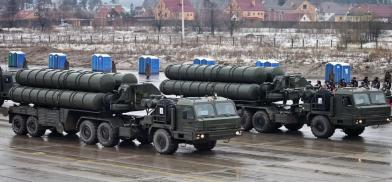US waiver to India bodes well for future of its strategic partnership
The waiver granted to India could be considered as a significant step towards strengthening the US military partnership with India

In the midst of lurking apprehension of US sanctions over the procurement of the S400 missile system, India has gone ahead with a $5 billion deal signed with Russia in October 2018 to augment its anti-ballistic capabilities. The S400 surface-to-air missile system was developed in 1990’s by “Almaz Antey”, a Russian state-owned community in arms industry to detect and combat varied aerial targets such as drones, fighter jets, bombers, and cruise and ballistic missiles up to a range of 600 km.
The S400 system with its long-range surveillance radars and control systems can identify, pick up and destroy an array of incoming targets simultaneously. The Russian S400 with its highly modernized system can be deployed as a reliable counter to neutralize threats. As compared to other typical Western systems offered to India by the US, India went ahead with S400 as it emerged as one of the most advanced stealth defence systems. The United States, Israel and Russia possess anti-defence missile systems of their own. China, Turkey and India have signed an agreement with their Russian counterpart and have received their supply of S400 regiments from Russia.
On June 15, 2017, the Us Senate (the upper chamber of the Congress) passed a resolution under the Countering America’s Adversaries through Sanctions Act which imposes sanctions on countries which knowingly engages in a significant transaction with defence or intelligence sectors of the government of Russia. Despite repeated interventions and warnings from the US and other NATO allies, Turkish President Recep Erdogan went ahead with the agreement with President Vladimir Putin to purchase the S-400 mobile surface-to-air missile system.
Turkey defiance
This heedless gesture led the US administration to impose sanctions on Turkey on December 14, 2020. Prior to that, in July 2019, the US suspended Turkey as a financial and manufacturing partner from the F35 programme alleging that the S400 poses threat to F35, America’s most expensive all-weather stealth multirole combat aircraft and at the same time it violates the terms of NATO allies.
A recent crisis in the relationship between Russia and the US-led West has been precipitated by Moscow’s blatant violation of Ukraine’s sovereignty. The Russian invasion of Ukraine which began in late February and initially centred on annexation of Crimea and war in Donbas between Ukraine and Russian-backed separatists further escalated in late 2021 with mobilization of Russian armed forces around Ukraine’s borders. This culminated in a full-scale invasion of Ukraine by Russia on February 24, 2022. Putin’s alarming statement that any Western intervention might provoke a lightning response in the form of nuclear war aggravated the rivalry between the two power blocs.
In order to effectively thwart the unjustified invasion of Ukraine and aggressive rhetoric of Russian officials, the European Union led by the US imposed a series of sanctions on Russia, thereby crippling its ability to finance the war. NATO allies and the US support to Ukraine with arms and ammunition indicate a new era of Russia as a global outcast. Some of the Western sanctions centre round import and export restrictions on Russia, exclusion of major Russian banks from Society for Worldwide Interbank Financial Telecommunications (SWIFT), travel restrictions imposed on influential Russian citizens and close acquaintances of President Putin and those involved in Crimean War.
Indian needs
The US being well aware of India’s strong defence ties with Russia and its historical dependency on Russian manufactured military items decided against sanctioning New Delhi keeping in view its future geostrategic partnerships. The US House of Representatives, in a historic move by a voice vote, passed a legislative amendment to the National Defence Authorization Act (NDDA) on July 14, 2022 in order to provide a one-time waiver to India under Countering America’s Adversaries Through Sanctions Act (CAATSA). This waiver to India for purchasing Russia’s S400 air defence system could be regarded as an important diplomatic gesture in the light of the US-India nuclear deal.
The amendment, which received unanimous support, was initiated by Indian-American Congressman Ro Khanna in order to convince and make it easy for President Joe Biden to stall CAATSA sanctions against India. Khanna states that the S400 defence system is the need of the hour for India to stall China’s belligerence in undermining the sovereignty of its neighbours. The waiver granted to India could be considered a significant step towards strengthening the US military partnership with India.
Territorial disputes in South Asia involving political, economic and social interests remain a perennial problem. These interstate disputes affect the bilateral and multilateral relations of neighbouring nations. The ongoing territorial disputes and military stand-off between Chinese and Indian forces at multiple locations have provided a perfect pretext for the Indian defence ministry to increase the size and diversity of its arsenals in order to confront the threat of nuclear warfare posed by its neighbours.
China factor
The pre-existing disputes between India and Pakistan over the Kashmir region with China entering the Kashmir fray as a third party have triggered further conflagration in South Asia. Given the geographic factors at play, the worsening Sino-Indian and India-Pakistan relationship challenges the stability and prosperity of the South Asian region.
The strained relations along the India-China Line of Actual Control and coordinated conspiracy launched against India by China and Pakistan have reconfirmed the need to develop its ballistic and air defence missile system. In the light of the threats along its border regions, the need of the hour for India is to develop its defence capabilities. It is in this context that India decided to procure an S400 missile defence system from Russia at an approximate cost of Rs 40,000 crores (over 50 mn USD).
(By Anindita Dutta, PhD Scholar at Tezpur University, Assam. Dr. Biswanath Gupta, Associate Professor of Law, OP JIndal University. Views are personal.)









Post a Comment